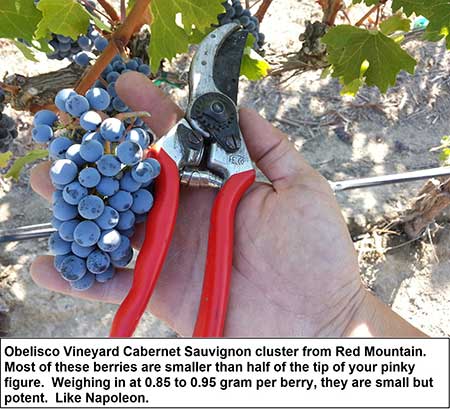Duckhorn Portfolio Wine Blog
Posts written by Neil Bernardi, Vice President of Winemaking and many special guest bloggers. This collection of insights on winemaking, farming, entertaining and more is a great way to learn about the excitement of winery life and tips for enjoying the wines we produce.
Greetings from Red Mountain
Greetings from Red Mountain in Washington State,
The first modern arrivals to this area were hardscrabble immigrants. They came in oxcarts and covered wagons via the Oregon Trail, to settle and farm in a region that promised good dirt, sunshine, and ample land.  They were homesteaders: hardworking rural Americans, Germans, Italians, and Irish. These and subsequent waves of migrants endured arduous journeys to get here, and they worked over tough ground once they arrived. They pulled rocks from fields. They dug canals and diverted streams. They planted wheat, potatoes, onions, orchards, and vineyards. They were a determined, thick-skinned people. (Photo Credit: University of Washington Photo Archive)
They were homesteaders: hardworking rural Americans, Germans, Italians, and Irish. These and subsequent waves of migrants endured arduous journeys to get here, and they worked over tough ground once they arrived. They pulled rocks from fields. They dug canals and diverted streams. They planted wheat, potatoes, onions, orchards, and vineyards. They were a determined, thick-skinned people. (Photo Credit: University of Washington Photo Archive)
I think about our wines from Canvasback in the context of this place where they are from: that they are the result of hard work in this land of extremes, their character defined by the thickness of their skin.
When it comes to making muscular, sumptuous Cab, it’s the skin that matters most, as it contains all the flavor, color, and textural bits that make a red wine. And while sugar is important for its role of turning boring old grape juice into a fun alcoholic beverage, we can all agree the yummy, fleshy, dark, brooding flavors; all the blackberry, plummy, dark cherry and spicy goodness of Cab, is coming from those skins.
Red Mountain generates very generous grape skin, thanks to its southwest-facing hillside located smack in the warmest part Washington. It is a natural solar panel that scoops up all the heat of afternoon sun. Midsummer daytime temperatures can stay above 100° F for several weeks during June and July, causing the skin of the berry to thicken in resistance to the sun. Consistent winds also engender thick skin development.  And that we are in a desert, in nutrient-poor soils, we tend to have small canopies and small clusters, with lots of little berries. It’s all about the skin to juice ratio.
And that we are in a desert, in nutrient-poor soils, we tend to have small canopies and small clusters, with lots of little berries. It’s all about the skin to juice ratio.
How does this translate into flavors in the glass? First, one notices the inherent bigness of Red Mountain Cabernets. While the tannins may be fully mature and ripe, there is noticeably high tannin. It gives the sensation of weight and intensity. It can be chewy and assertive on the palate.
These thick-skinned cabs make for wines that demand your time, your patience. It takes a year or so in bottle for them to come back together. They start to really hit their stride around year six. At 20-30 years, they are on full afterburn, glowing with refined energy like a hardwood coal in the heart of a bonfire. Slowly is the power of the sun un-packed.
The thickened skins can make for formidable wines. Our charge is to take something tough and make it into something beautiful. Think of it like making a rock-solid table from a nice piece of oak. With craftsmanship and raw materials like these, we can make something both enduring and delicious.
